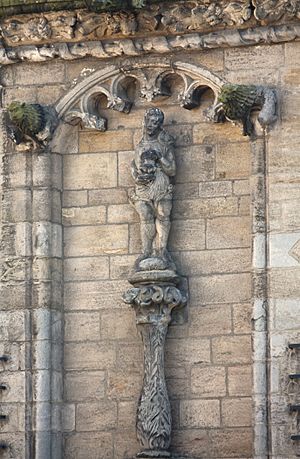Oliver Sinclair facts for kids
Sir Oliver Sinclair of Pitcairnis was a close friend and helper of James V of Scotland, who was King of Scotland. He lived a long time ago, around the 1500s. People tell different stories about him. One famous story says King James V put him in charge of the Scottish army at a battle called Solway Moss. Another story tells how he showed a rich servant of Regent Morton that even important people can lose their power.
Contents
Life at the Royal Court

Oliver Sinclair was the third son in his family. His family was not super rich, but they were important enough to work for the King. Oliver and his wife, Katherine Bellenden, helped manage the King's money. They worked with another courtier named John Tennent.
Oliver even looked after the King's money when James V traveled to France in 1537. He bought fancy feathers for the King's clothes and for parties. He also bought more feathers in 1541. Oliver and John Tennent also helped Mary of Guise, the Queen, practice her archery in 1542. As a special gift for Christmas in 1539, Oliver brought 196 rabbits to court for the King.
Oliver's official job at court was "cupbearer." This meant he served drinks to the King. He received special clothes for Christmas, which were worth £20. This was a good amount of money back then. For example, the King's laundress received £13, and kitchen workers received much less.
When the King's mother, Margaret Tudor, was very sick in 1538, Oliver and John Tennent rode with the King to see her. She had already passed away when they arrived. Oliver and John were then asked to pack up her belongings.
The Battle of Solway Moss
Oliver Sinclair was captured by the English army at the Battle of Solway Moss in November 1542. He was listed as a prisoner, but not a very important one. He was later released. To make sure he didn't run away, the son of another Scottish lord, the Laird of Cleisburn, was kept as a hostage in England.
A Scottish nobleman named George Douglas of Pittendreich told the English King, Henry VIII of England, that Oliver Sinclair had been in charge of the Scottish army at Solway Moss. However, the English commanders who fought in the battle did not mention Oliver being in command.
George Douglas also spread a story that King James V was very sad and sick after the battle. He said the King kept talking about losing his battle flag and Oliver being captured. This story made it seem like Oliver was very important to the King. Whether Oliver was truly in command or not, these stories show that some powerful Scottish nobles were jealous of Oliver. They didn't like that King James V gave important jobs to people like Oliver, who were not from the most powerful families.
The Laird of Cleisburn's son was still a prisoner even after another battle called Pinkie in 1547. He was finally released in February 1548. Oliver Sinclair himself received £50 from Edward VI of England, the new English King, when the hostage deal was finished.
A writer named David Hume of Godscroft wrote a story around 1600 about Oliver Sinclair. He said that in the 1570s, Regent Morton had a servant named George Auchinleck. This servant controlled who could see Regent Morton. One day, Oliver Sinclair came to Edinburgh and got Auchinleck's attention. When Auchinleck asked what he wanted, Oliver simply said, "I am Oliver Sinclair," and then left. Hume of Godscroft explained that Oliver meant that Auchinleck, who was very powerful then, would also become unimportant one day. People talked a lot about this event at the time.
Different Stories of Solway Moss
George Douglas of Pittendreich's story about Solway Moss was that King James V had left the Scottish army. Then, Oliver Sinclair was made commander instead of Lord Maxwell, who was supposed to be in charge. Some Scottish soldiers refused to fight because they didn't want Oliver as their leader. Because of this, the battle was lost. Many Scottish writers in the 1500s believed this story.
However, about 80 years later, a writer and poet named William Drummond of Hawthornden shared a different version. Hawthornden said the Scottish army lost because of a misunderstanding. He believed Oliver was only supposed to tell the army that Lord Maxwell was in command. But when Oliver was lifted up to speak, the worried soldiers thought he had been made the new leader. While they were confused, the English army attacked.
Family Life
Oliver Sinclair was married to Katherine Bellenden. They had a daughter named Isobel. Isobel married James Hamilton of Bothwellhaugh. He was involved in the assassination of Regent Moray in 1570.
Sources
- Cameron, Jamie, James V, Tuckwell, (1998), (see pp. 273–275, 293–294, 316–321)
- Sinclair, G. A., 'The Scots at Solway Moss, Scottish Historical Review, vol. 2 (1905), pp. 357–377.

